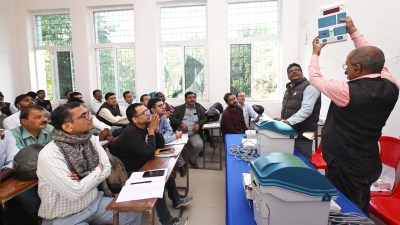ASI stumbles upon 13th Century tomb-like structure in Siri Fort
ASI officials said the opening of the arched structure has been discovered and no further excavation will be conducted to dig out the rest of the structure, which still remains buried.
 The structure was discovered during renovation. Abhinav Saha
The structure was discovered during renovation. Abhinav Saha A tomb-like structure was accidentally discovered in the Siri Fort area while the Archaeological Survey of India (ASI) was carrying out renovation work at the Siri Fort Children’s Park around three months ago.
ASI officials said the opening of the arched structure has been discovered and no further excavation will be conducted to dig out the rest of the structure, which still remains buried.
“The structure will be kept intact to showcase it to the children who visit the museum and to explain to them how half-buried structures are discovered. No large-scale excavation will take place,” said Praveen Singh, Superintending Archaeologist of the Delhi Circle of ASI.
Siri Fort was built in the 13th Century by Alauddin Khilji, considered to be the most powerful ruler of the Khilji dynasty.
“It was used as a garrison town where his army used to reside. Hauz Khas village was an extension of the fort, which was designed to meet the water needs of the army. The fort is currently in ruins and the only structure that remains is its boundary walls,” said author-historian Sohail Hashmi, who also conducts heritage walks in Delhi.
The Siri Fort Children’s Museum was built in 2011 and is located opposite Shahpur Jat village. The park has about 30 replicas of popular monuments from around the world and the recent renovations were taking place to install about 100 more such replicas, during which the tomb-like structure was found.
“So far, only a low-height structure has been discovered, 2 to 3 metres of which has been excavated. We are not aware of what lies inside the structure, but it is unlikely to be a tunnel,” said Singh.







